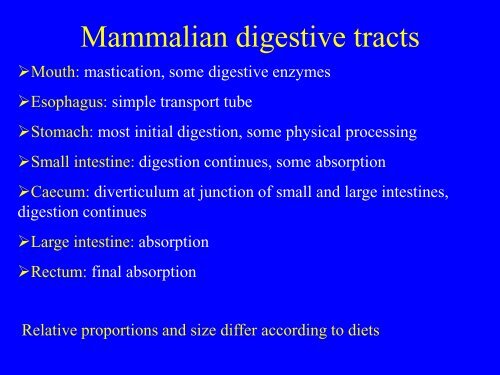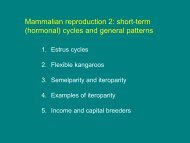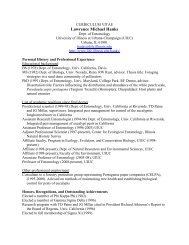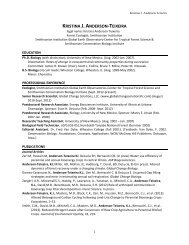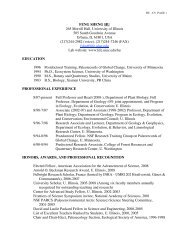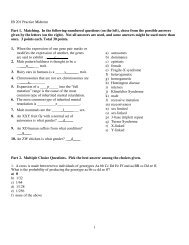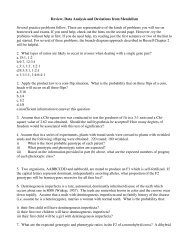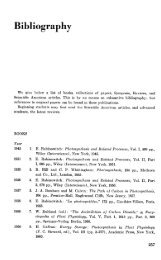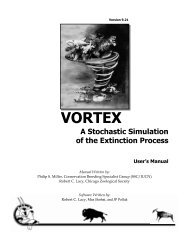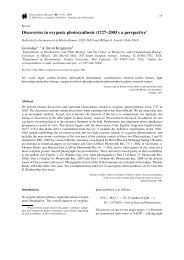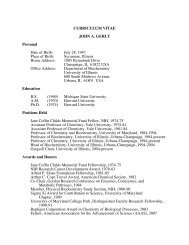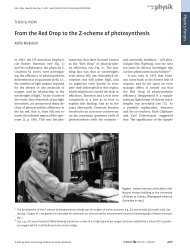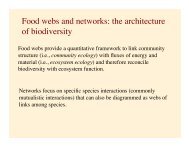Mammalian digestive tracts
Mammalian digestive tracts
Mammalian digestive tracts
You also want an ePaper? Increase the reach of your titles
YUMPU automatically turns print PDFs into web optimized ePapers that Google loves.
<strong>Mammalian</strong> <strong>digestive</strong> <strong>tracts</strong><br />
Mouth: mastication, some <strong>digestive</strong> enzymes<br />
Esophagus: simple transport tube<br />
Stomach: most initial digestion, some physical processing<br />
Small intestine: digestion continues, some absorption<br />
Caecum: diverticulum at junction of small and large intestines,<br />
digestion continues<br />
Large intestine: absorption<br />
Rectum: final absorption<br />
Relative proportions and size differ according to diets
Plant material is more difficult to<br />
digest, so <strong>digestive</strong> tract longer<br />
and more complex in herbivores
Problem: most E in leaves/grass not stored in cell contents, but<br />
locked up in structural carbohydrates like cellulose. No enzyme<br />
produced by mammals can digest cellulose.<br />
Solution: Some bacteria and protozoans can! House these in<br />
specialized compartments and let them do the work.<br />
Hindgut fermenters house symbionts primarily in caecum,<br />
foregut fermenters (ruminants) house them mainly in complex<br />
forestomach.<br />
Hindgut: many rodents, perissodactyls, rabbits, sirenians,<br />
hyraxes, elephants, some marsupials<br />
Foregut: artiodactyls, sloths, kangaroos
% volume of <strong>digestive</strong> tract<br />
Carnivore<br />
(dog)<br />
Hindgut F<br />
(horse)<br />
Foregut F<br />
(sheep)<br />
stomach 65 9 67*<br />
small<br />
intestine<br />
20 30 20*<br />
caecum
3 basic patterns:<br />
Carnivores/insectivores: food (meat) is easy to process and<br />
digest, so<br />
1. Relatively short post-gastric tract (2-6 X HBL)<br />
2. Caecum reduced or absent<br />
3. Little differentiation between small and large intestines<br />
Other 2 patterns are 2 major kinds of herbivores = hindgut and<br />
foregut (ruminant) fermenters<br />
Deal with housing and using microbes in different ways<br />
(see next slide, also the many <strong>digestive</strong> <strong>tracts</strong> shown on your<br />
handout)
post-gastric = 10-15 X body length<br />
large caecum<br />
long, sacculated lg. intestine<br />
hindgut foregut<br />
lg., compartmentalized stomach<br />
longest post-gastric = 20-27 X body length<br />
reduced caecum, lg intestine not sacculated
Advantages of microbial fermentation:<br />
1. break down cellulose into volatile fatty acids<br />
2. microbes grow and reproduce, plus can fix inorganic N (from<br />
urea) into protein, namely their bodies, which can be digested<br />
(yielding all essential amino acids, vitamins except A + D,<br />
about 100-180 g protein per day from low quality food)<br />
3. can conserve water because urea (waste product of protein<br />
digestion) gets converted to more protein instead of excreted<br />
(foregut benefit more from 2 and 3... some hindgut use<br />
coprophagy to run food through a second time to better digest<br />
and absorb the work of those microbes, YUCK)<br />
4. microbes also can break down many plant defensive<br />
compounds
Koalas have the largest relative<br />
caecum of any mammal<br />
Folivores generally have lower<br />
metabolic rates, sometimes lower<br />
body temperatures, and spend a<br />
LOT of time sleeping (to<br />
conserve E) and digesting.<br />
Folivores: specialize on<br />
eating leaves... very low<br />
quality diet!
Hindgut fermenters process food about 2X faster<br />
Foregut fermenters about 3/2 X more efficient at extracting<br />
nutrition; longer time for fermentation allows more production<br />
of protein and breakdown of toxic compounds by symbionts<br />
So, when food is abundant and good quality (conditions<br />
optimal), hindgut fermenters can obtain more energy per day.<br />
When food becomes limiting, ruminants can extract more from<br />
it, and therefore obtain more energy per day.<br />
Ruminants feed in bouts, however, which is why the smallest<br />
(like voles) and largest (like rhinos and elephants) herbivores are<br />
foregut fermenters.
Wildebeest – 230 -275 kg, ruminant Zebra – 350 kg, hindgut<br />
Thompson’s gazelle – 20 kg,<br />
ruminant<br />
3 most numerous species<br />
during Serengeti migrations
Mammals are not just passive components of<br />
ecosystems, simply responding to their habitat.<br />
<strong>Mammalian</strong> activity, including feeding, can affect<br />
successional processes and change the appearance of<br />
the landscape.<br />
Here are just a few examples.
Browsing by elephants, giraffes,<br />
and impala opens up forest habitat,<br />
slows re-growth of saplings and<br />
shrubs, and together with altered<br />
fire regime, maintains open<br />
habitats like savannas
Thus, competitive advantage of<br />
perennial grasses reduced, diversity of<br />
annuals and forbs increases.<br />
Wallows can create spring pools, add to<br />
spatial heterogeneity. Urine, feces, and<br />
carcasses create local N-rich patches.<br />
Bison affect prairies both by<br />
grazing and wallowing.<br />
Grazers on grass, woody and forbs<br />
Moose are browsers. (about 15 kg/day)<br />
Same things in spruce that affect moose microbes also<br />
affect soil litter microbes. Thus, litter composition<br />
(spruce/fir opposed to aspen, etc.) affects soil N.<br />
Feed selectively. Prefer early successional species<br />
like aspen, paper birch, balsam poplar. Almost<br />
never eat spruce, rarely balsam fir (when really<br />
hungry)<br />
Spruce has high resin, lignin content, low N. (Bad<br />
for moose digestion)<br />
Moose-browsed species over-topped by<br />
spruce/fir...affects forest tree composition (shown by<br />
exclosure experiments). But not only tree composition,<br />
changes in soil microbes and nutrients affect rates of<br />
plant growth and other species of forest plants.<br />
Note: wolves good!<br />
hungry moose!
• Exclosures for 40+ yrs<br />
• Selective browsing by deer<br />
affect tree growth, alter species<br />
composition<br />
• Critical concern: rare and<br />
sensitive understorey plants,<br />
esp. springtime plants,<br />
hammered by deer<br />
White-tailed deer in Wisconsin:<br />
because of forestry and wildlife<br />
management practices, way<br />
higher numbers of deer now that<br />
in pre-settlement period
Densities can be locally high, but<br />
patchy, spatially variable.<br />
Prefer forbs over grass, esp. species<br />
with succulent, below-ground storage<br />
organs.<br />
Flora on mounds differs from other<br />
veg. (light availability, subsurface<br />
soil lower N), opens patches for good<br />
colonizers but poor competitors.<br />
Pocket gophers<br />
burrow and tunnel<br />
extensively.<br />
Move lots of soil, lots<br />
deposited on surface<br />
in mounds.<br />
No gophers: Perennial grasses take over<br />
and diversity decreases.<br />
Gopher foraging on tree seedlings slows<br />
succession, invasion of fields by trees.<br />
Latrines and storage rooms create small<br />
N-rich patches (increases spatial<br />
heterogeneity).<br />
Grasshoppers like to lay eggs in softer<br />
soil of mounds, increases arthropod<br />
diversity!
Could note lots of other studies showing effects of mammals<br />
on plant communities: Squirrels and mice selectively harvest<br />
white and red oak acorns; voles and bog lemmings help stop<br />
trees from invading old fields; kangaroo rats affect desert<br />
plant communities and also inhibit invasion by grasses;<br />
many mammals are important seed dispersers, pollinators,<br />
dispersers of ectomycorhizal fungi, etc.<br />
But now let’s look beyond interactions between 2 trophic<br />
levels (herbivores and plants) and add a third trophic level…
Bottom-up effects (proportional changes)<br />
Classic “trophic pyramid” model: add resources at the<br />
bottom, get positively correlated changes up the trophic<br />
chain<br />
Top-down effects (trophic cascades)<br />
Change in one level (say, top predator) results in<br />
changes at next lower level in opposite direction, with<br />
effects cascading down the trophic chain
Kelp forests are rich,<br />
diverse marine<br />
habitats.<br />
Sea urchins graze on<br />
algae, including kelp.<br />
Sea otters eat a variety<br />
of molluscs, including<br />
sea urchins.<br />
No sea otters, urchins increase<br />
and devastate kelp... leave a<br />
marine desert.<br />
Sea otters present, keep urchin<br />
numbers down, and kelp forest<br />
thrives.<br />
Killer whales eat otters, kelp<br />
declines!
Other mammalian top-down examples include:<br />
wolves, moose, and fir trees on Isle Royale, and<br />
wolves, elk, and aspen and willows in Yellowstone<br />
An interesting example of bottom-up effects is<br />
shown by the many consequences of mast years in<br />
eastern deciduous forests (refer to handout)
OK, didn’t quite finish this one in<br />
time, you’ll have to refer to the<br />
handout for the oak forest story!


